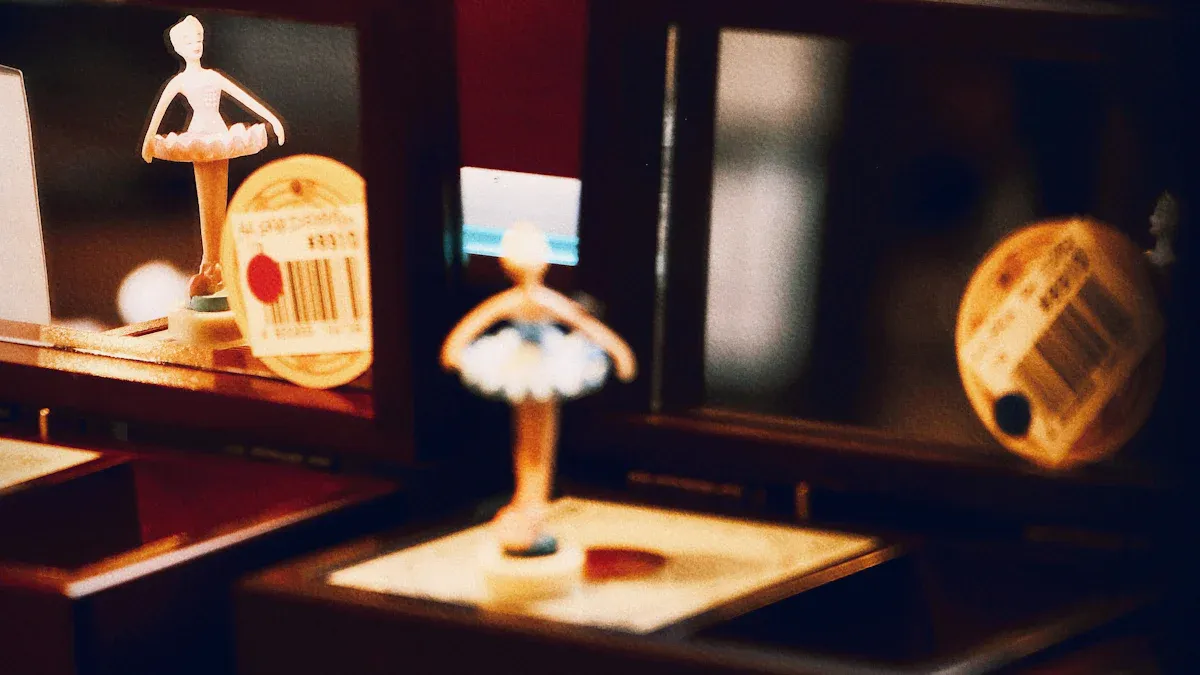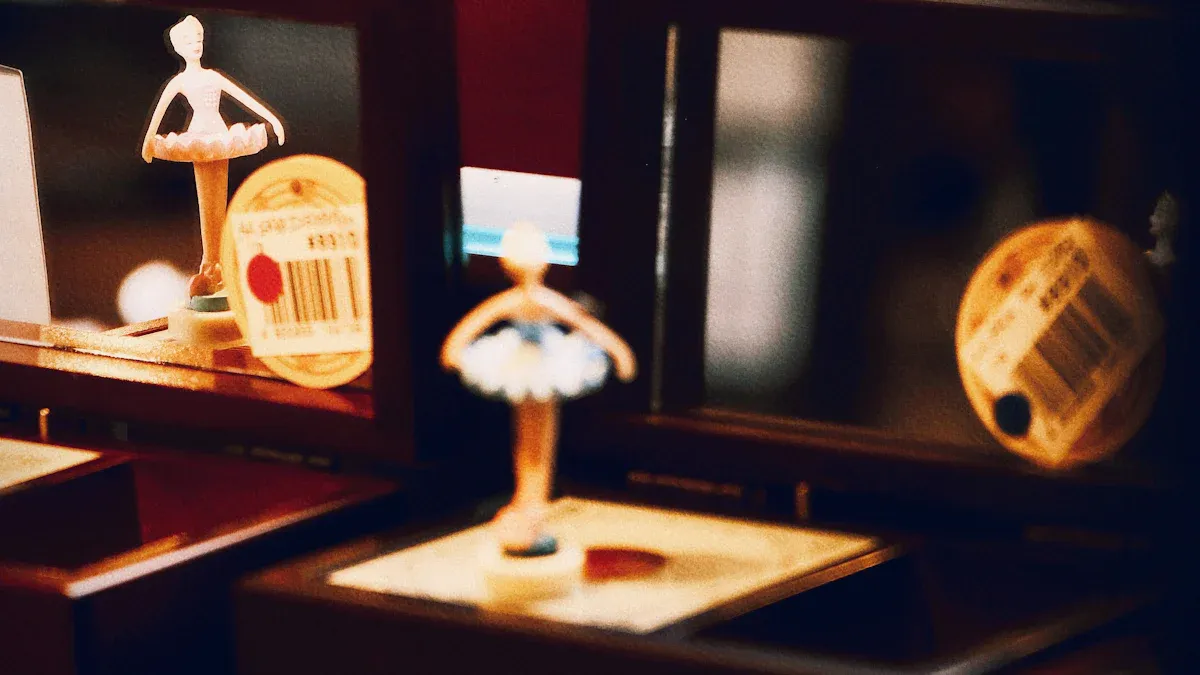
Customizing Music Box Cores offers a unique opportunity to enhance the charm of plastic toys. The integration of a music box movement transforms ordinary toys into interactive and memorable creations. By modifying the music box mechanism, designers can craft music box mechanisms tailored to specific themes or melodies. This personalization elevates toys into cherished keepsakes. Technical expertise ensures the seamless adaptation of a Customized Gift Box Music Core, maintaining both sound quality and durability.
Key Takeaways
- Changing music box cores makes plastic toys more fun and special.
- Correct sizes and good materials help the music box fit and sound great.
- Checking and improving the product makes sure it works well and looks nice.
Understanding Music Box Cores for Customization
Key Components of Music Box Cores
Music box cores consist of several essential components that work together to produce melodies. The primary parts include the comb, which contains tuned metal teeth, and the cylinder or disc, which holds the encoded melody. A spring mechanism powers the movement, while a governor regulates the playback speed. These components ensure the core delivers consistent sound quality. Designers often choose specific core types based on the toy’s size and functionality. For example, miniature musical movements fit compact toys, while deluxe movements suit larger designs requiring richer sound.
How Music Box Cores Operate in Toys
Music box cores operate by converting mechanical energy into sound. When the spring is wound, it stores energy that powers the cylinder or disc. As the cylinder rotates, its pins pluck the comb’s teeth, creating musical notes. In plastic toys, the core integrates seamlessly into the design, often activated by a button or winding key. This mechanism adds an interactive element, enhancing the toy’s appeal. Proper alignment of the core within the toy ensures smooth operation and optimal sound projection.
Benefits of Customizing Music Box Cores
Customizing music box cores allows designers to tailor toys to specific themes or audiences. Personalized melodies can evoke emotional connections, making the toy more memorable. Additionally, customization enables the use of various core types, such as standard 18-note movements or paper strip hand-operated movements, to suit different design needs. This flexibility enhances both the toy’s functionality and its market appeal. Companies like Ningbo Yunsheng Musical Movement Manufacturing Co., Ltd. provide a wide range of customizable options, ensuring high-quality results.
Technical Process for Customizing Music Box Cores

Disassembling and Analyzing the Core
The first step in customizing music box cores involves carefully disassembling the existing mechanism. This process requires precision to avoid damaging delicate components like the comb or cylinder. Using tools such as small screwdrivers and tweezers, technicians can separate the parts for closer inspection. Each component, including the spring, governor, and tines, should be analyzed for wear and compatibility with the intended design. This analysis helps identify areas that may require modification or replacement to achieve the desired functionality.
Measuring and Designing for Compatibility
Accurate measurements ensure the customized core fits seamlessly into the toy’s structure. Designers use calipers and rulers to measure the dimensions of both the music box core and the toy’s housing. These measurements guide the creation of a blueprint or digital model for the modified core. Compatibility extends beyond physical dimensions; the core’s weight and balance must also align with the toy’s design to maintain stability and performance. By prioritizing precision during this stage, designers can avoid issues during assembly.
Material Selection for Durability and Sound Quality
Choosing the right materials is crucial for both durability and sound quality. Metals like aluminum or brass are often used for the comb and cylinder due to their excellent acoustic properties. For plastic toys, lightweight materials may be preferred to prevent strain on the toy’s structure. Designers must also consider the material’s resistance to wear and environmental factors, such as humidity, which can affect sound production. Companies like Ningbo Yunsheng Musical Movement Manufacturing Co., Ltd. offer high-quality components that meet these requirements, ensuring long-lasting performance.
Tools and Techniques for Modification
Customizing music box cores requires specialized tools and techniques. Precision cutting tools are used to modify the tines for specific musical notes, while files and sandpaper smooth out rough edges. For tuning, technicians rely on tuning forks or digital tuners to ensure each note matches the desired melody. Assembly tools, such as clamps and adhesive, help secure components during reassembly. Following a structured approach, as outlined in technical guides, ensures the modifications enhance the core’s functionality without compromising its integrity.
- Building the Music Box Core: This step involves constructing the core using materials like aluminum plates and tines, which can be adapted for plastic toys.
- Customization of Tines: Cutting and tuning the tines to produce specific musical notes is essential for achieving the desired melody.
- Final Assembly and Tuning: Assembling the components and fine-tuning them ensures the music box operates smoothly and produces high-quality sound.
Creating Custom Cores Using 3D Printing
3D printing offers a modern solution for creating custom music box cores. Designers begin by measuring an existing core and using software like Python to generate a 3D model of the new component. This model is then printed using materials such as PLA or ABS, which are lightweight and durable. A case study demonstrated the successful creation of a custom music box cylinder using this technique. The final product was a playable cylinder compatible with standard mechanisms, showcasing the potential of 3D printing in music box customization. This method not only reduces production time but also allows for intricate designs that would be difficult to achieve manually.
- A detailed case study highlighted the process of designing and printing a custom cylinder for a music box.
- The steps included measuring the original core, creating a digital model, and producing a functional cylinder using 3D printing.
- The result was a high-quality, playable component that integrated seamlessly with existing music box cores.
Integrating Music Box Cores into Plastic Toys

Ensuring Structural Compatibility
Integrating music box cores into plastic toys requires careful planning to ensure structural compatibility. Designers must evaluate the toy’s internal dimensions and layout to determine the best placement for the core. A snug fit prevents unnecessary movement, which could affect sound quality or damage the mechanism.
Using a digital model of the toy’s interior can streamline this process. By overlaying the core’s dimensions onto the model, designers can identify potential conflicts, such as interference with other components or insufficient space for the winding mechanism. Adjustments to the toy’s design, such as adding support brackets or modifying internal walls, may be necessary to accommodate the core without compromising the toy’s aesthetics or functionality.
Tip: When working with lightweight plastic toys, reinforcing the area around the core with durable materials can enhance stability and prevent wear over time.
Securing the Core for Long-Term Use
Properly securing the music box core is essential for ensuring its longevity and consistent performance. Designers often use screws, clips, or adhesive to anchor the core within the toy. Each method has its advantages, depending on the toy’s material and intended use. For example, screws provide a strong, removable connection, while adhesive works well for lightweight toys with limited space.
To prevent vibrations that could distort the sound, designers should incorporate padding or rubber gaskets around the core. These materials absorb shocks and reduce noise caused by mechanical movement. Additionally, aligning the core with the toy’s center of gravity minimizes strain on the structure, especially for toys that are frequently handled or played with.
Note: Testing the toy’s durability under various conditions, such as repeated winding or exposure to minor impacts, can help identify weak points in the securing mechanism.
Testing and Refining the Final Product
Thorough testing ensures the music box core operates seamlessly within the toy. Designers should evaluate the toy’s functionality by winding the core, activating the melody, and observing the sound quality. Any misalignment or loose components can result in muffled notes or mechanical failure.
A checklist can streamline the testing process:
- Verify the core’s stability within the toy.
- Check the alignment of the winding mechanism and activation button.
- Assess the sound projection and clarity of the melody.
- Test the toy’s durability through simulated play scenarios.
If issues arise, designers can refine the product by adjusting the core’s placement, reinforcing weak areas, or fine-tuning the mechanism. Collaborating with manufacturers like Ningbo Yunsheng Musical Movement Manufacturing Co., Ltd. can provide access to high-quality components and expert guidance, ensuring the final product meets both functional and aesthetic standards.
Pro Tip: Documenting the testing and refinement process can serve as a valuable reference for future projects, reducing development time and improving overall efficiency.
Customizing music box cores transforms plastic toys into unique, interactive creations. This process enhances both functionality and emotional value. Designers should explore innovative techniques and experiment with melodies to create memorable toys.
Connect with Experts: Ningbo Yunsheng Musical Movement Manufacturing Co., Ltd. offers high-quality components and expert guidance to support your creative journey.
FAQ
What tools are essential for customizing music box cores?
Technicians need precision tools like small screwdrivers, tweezers, tuning forks, and digital tuners. These tools ensure accurate disassembly, tuning, and reassembly of the core.
Tip: Investing in high-quality tools improves efficiency and reduces the risk of damaging delicate components.
Can 3D printing be used for all music box core parts?
3D printing works best for non-metallic components like housings or lightweight cylinders. Metal parts, such as combs, require traditional manufacturing for optimal sound quality.
How can designers ensure the melody matches the toy’s theme?
Designers should select melodies that resonate with the toy’s target audience. Collaborating with manufacturers like Ningbo Yunsheng Musical Movement Manufacturing Co., Ltd. ensures access to customizable options.
Note: Testing the melody within the toy’s structure ensures sound clarity and emotional impact.
Post time: May-20-2025
